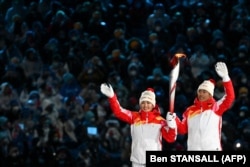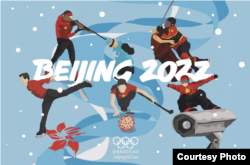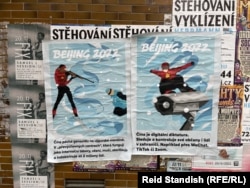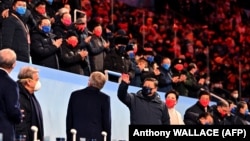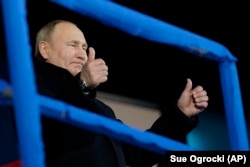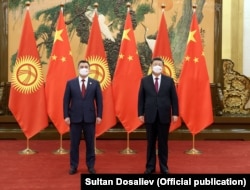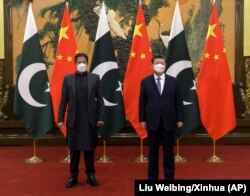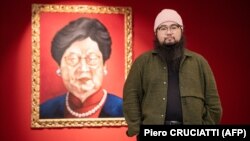
A Chinese dissident takes aim at Beijing's rights abuses in Xinjiang, Hong Kong, and beyond.
The Beijing Winter Olympics have been shrouded in controversy, with many saying China is a problematic host for such an event due to its rising authoritarianism and poor human rights record.
One of the loudest critics of China hosting the games is a famous Chinese artist and dissident living in Australia known only by the pseudonym Badiucao, whose new series of art and videos recreate images of Olympic sporting events that double as depictions of Chinese government abuse.
At first glance, they appear to be promotional billboards for the Beijing Olympics, but a closer look reveals why Badiucao and many others see China as an unfit host: a Chinese hockey player bloodying a Tibetan monk; a snowboarder atop a surveillance camera; a Chinese biathlete poised to execute a member of the country’s persecuted Uyghur minority; and a curler sending a coronavirus cell down the ice, representing China's delay in warning the world about the outbreak of COVID-19.
For the 35-year-old Badiucao, the guerrilla art campaign -- which has gained a global following -- is a chance to push back against Beijing as it uses the global sporting event to try to put a polish on Western criticism about its human rights record and spread a narrative that the Chinese Communist Party has built an inclusive and prosperous political model at home.
“As an artist, it’s my job to do something that channels this attention on China towards the conversation that the world should be hearing and what the government is trying to hide,” Badiucao told RFE/RL. “This is obviously not what the Chinese government wants to tell the world and would instead prefer to push this idea that everything is fine and everyone is happy.”
Badiucao is no stranger to courting controversy and using his art to provoke a conversation, with over a decade of work lambasting the Chinese government and the country’s president, Xi Jinping, in particular. His work as a political cartoonist has also taken aim at Chinese censorship at home and increasingly around the world -- with Western complicity -- as well as Beijing’s crackdown on activists in Hong Kong.
He’s also increasingly focused on the brutal dragnet that has swept more than 1 million Uyghurs, ethnic Kazakhs, and other Muslim minorities into detention camps and prisons in China’s western Xinjiang Province. The actions of Chinese authorities -- who have been accused of using forced birth control, indentured labor, and erasing Uyghur cultural and religious identity -- have drawn accusations of genocide from international rights groups and several Western governments.
Beijing has repeatedly denied the genocide allegations, saying the camps were established to fight extremism. Chinese authorities have also rigorously pushed back at criticism over its actions in Xinjiang and continue to do so at the Olympics.
During the opening ceremony in Beijing, Dinigar Ilhamjan, a Uyghur Olympic athlete, was selected to light the flame in the main stadium, which the country’s state-run media outlets quickly held up as evidence that Beijing is not persecuting Uyghurs and other Muslim minorities.
“This is propaganda. There’s no other way to describe it,” Badiucao said. “This is exactly what [China] wants to use the Olympics for. They want to show the world that everyone has a smile on their face and that all these reports and evidence about what is happening in Xinjiang are not actually true.”
Art Vs. Censorship
In China, censorship has long been a reality for the country’s cultural sphere, and the already-narrow space for free expression has only continued to shrink since Xi’s rise to leadership in 2012. Inside the country, it has become increasingly common for works and even entire art shows -- whether political or not -- to be pulled at the request of Chinese authorities.
This has also grown beyond its borders in recent years, as China's vast censorship system -- fueled by its mounting economic strength and political influence -- has successfully extended its reach to other countries around the world.
Badiucao, who is routinely attacked by Chinese state-media outlets, knows this firsthand.
His art show in Brescia, Italy, in November 2021 almost didn’t happen following direct requests and even threats from Chinese officials to cancel the exhibit.
“I wear these attempts at censorship as a badge of honor,” he said.
The show in Italy contained many provocative works touching on topics that are taboo or even illegal inside China, such as a hybrid portrait of Xi and Hong Kong chief executive Carrie Lam; a display commenting on the brutal Tiananmen Square massacre in 1989; and a series of cartoons poking fun at a popular Internet meme of Xi and U.S. President Barack Obama that compared the Chinese leader to the Disney cartoon character Winnie-the-Pooh.
The image, which also showed Obama as his companion character Tigger, was quickly censored when it first appeared, with any version or mention of the meme scrubbed from the Chinese Internet.
“I see art as a way to start a conversation,” said Badiucao. “It can be a way to challenge people and provoke them to pay attention to things that matter.”
Badiucao had worked for years to keep his identity a secret out of fear of reprisal from the Chinese government and preferred to remain completely anonymous.
But in October 2018, just weeks before his first exhibit in Hong Kong was set to open, his life was turned upside down when Chinese officials uncovered his identity and his family members were detained and interrogated because of his activism.
The Hong Kong show was canceled and Badiucao said he has since cut off contact with family in China in order to protect them. He’s also slowly come out of the shadows, revealing his face for the first time in a 2019 documentary and since taking on a more public role despite the growing pushback form Chinese authorities to his work.
“The resistance from the Chinese authorities can be felt stronger than before,” Badiucao said. “The censorship and threats I receive are getting worse every day. I’m getting death threats sent to me and I still have a hard time getting [my work] into galleries [due to Chinese intervention].”
Drawing Truth To Power
The poster campaign centered around the Olympics has grown into an organic global effort, with fans downloading the posters and having them printed for public posting. They have been seen all around the world, from Miami Beach to Prague and Melbourne.
But the grassroots effort has stirred controversy of its own, most notably at a major American university in February.
Students had put up the posters highlighting Beijing’s human rights abuses on the campus of George Washington University in Washington, D.C., but they were later removed by the university following a complaint by the local chapter of the Chinese Students and Scholars Associations (CSSA), a global organization that is sponsored and monitored by the local Chinese embassy or consulate in its host country.
Leaked e-mails obtained by the U.S. media outlet Axios show that the CSSA complained directly to university President Mark Wrighton, calling the posters an “attack on the Chinese nation” and that they included “serious racist views.”
Wrighton initially sided with the CSSA, saying he was personally offended by the posters, and ordered them to be removed. Following a public uproar, Wrighton backtracked and issued a public statement admitting he was wrong to remove the posters, which he said were not targeted toward the Chinese people but the government’s human rights record.
For Badiucao, the episode was a frustrating, but familiar, incident. He said that accusations of racism to deflect criticism over the government’s human rights abuses is a common tactic that proves to be largely effective.
“This is part of a global playbook to censor people,” Badiucao said. “Chinese authorities are always trying to show that the Chinese people and the government are the same thing and that criticizing the government is the same as attacking its people.”
Despite lingering frustrations over how the incident was first handled by Wrighton, Badiucao said he is “cautiously positive” about the space for his work and how it is having an impact in shifting the conversation about the Chinese government.
In the West in particular, many governments and corporations continue to stay silent when it comes to abuses like those targeted against Uyghurs or the crackdown under way in Hong Kong in order to avoid backlash from Beijing and maintain access to China’s lucrative financial market.
Badiucao hopes that campaigns like the Olympic posters can play a small part in changing the way the world sees the Chinese government.
“Unlike politicians or corporations, [artists] are not blinded by agenda or short-term profit,” Badiucao said. “Art is a great way to tell the truth about China to people of all backgrounds and do it in a way that is still interesting and enlightening.”






